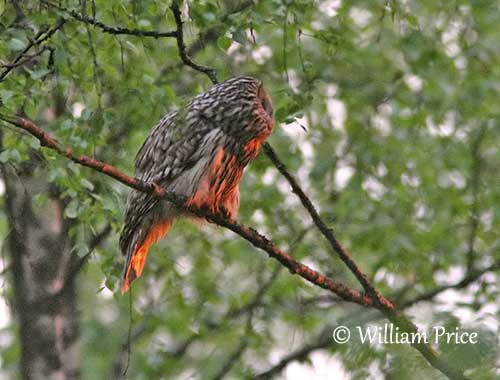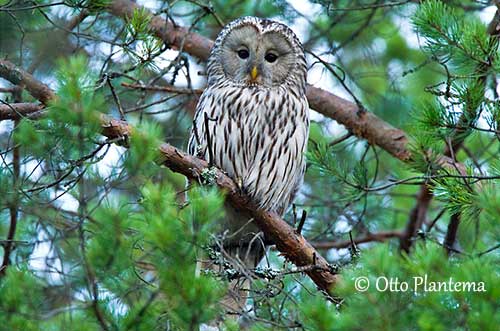
Fr: Chouette de l’Oural
Ang: Ural Owl
All: Habichtskauz
Esp: Cárabo Uralense
Ita: Allocco degli Urali
Nd: Oeraluil
Sd: Slaguggla
Photographers:
John Anderson
John Anderson Photo Galleries
Otto Plantema
Trips around the world
William Price
PBase-tereksandpiper & Flickr William Price
Ingo Waschkies
My bird pictures on Pbase
Text by Nicole Bouglouan
Sources :
HANDBOOK OF THE BIRDS OF THE WORLD Vol 5 by Josep del Hoyo-Andrew Elliott-Jordi Sargatal - Lynx Edicions - ISBN: 8487334253
THE HANDBOOK OF BIRD IDENTIFICATION FOR EUROPE AND THE WESTERN PALEARCTIC by Mark Beaman, Steve Madge - C.Helm - ISBN: 0713639601
OWLS OF THE WORLD – By Claus König, Friedhelm Weick and Jan-Hendrik Becking - IBSN 978-0-7136-6548-2
L’ENCYCLOPEDIE MONDIALE DES OISEAUX - Dr Christopher M. Perrins - BORDAS - ISBN: 2040185607
Wikipedia (Wikipedia, The Free Encyclopedia)
Rainforest Alliance – Ural Owl
Stump nests of the Ural Owl Strix uralensis in Hokkaido
Ural Owl
Strix uralensis
Strigiformes Order – Strigidae Family
INTRODUCTION:
The Ural Owl is included in the tribe Strigini in the subfamily Striginae. The owls of genus Strix are relatively large. They live in a variety of forested habitats.
Like numerous Strigidae, the Ural Owl is mainly active at night, from dusk to just before dawn. It roosts in trees, among the dense foliage during the day. The wide range extends from Scandinavia to Japan and Korea, and the birds are resident, even sedentary, with wandering in autumn and winter, but mostly in W and C Siberia.
The Ural Owl is known as an aggressive bird. It often attacks humans approaching or entering its territory, especially during the nesting period.
This species has currently stable populations due to provision of nest boxes in some parts of the range, in order to replace habitat loss through forestry management.
DESCRIPTION OF THE BIRD:
Biometrics:
Length: 50-62 cm
Wingspan: 124-134 cm
Weight: M: 500-950 g – F: 570-1300 g
Compared to other Strigidae, the Ural Owl is rather pale overall. The upperparts are greyish to brownish-grey with blackish and white streaking. Back and scapulars show long feathers with white fringes. There is a white row across the shoulders, formed by the large white areas of the scapulars. The flight feathers are barred dark and pale brownish. The fairly long tail is dark brown and shows 5-7 broad greyish-white bars.
The underparts are pale greyish-white to whitish, with heavy brown streaking, but vent, undertail-coverts, thighs and tarsi are white. The throat is whitish.

On the head, the round facial disc is whitish to pale ochre-grey. It is bordered by a rim formed by small, pearl-shaped blackish and white spots.
The bill is yellow-horn with yellowish cere. The eyes are dark brown. Legs and feet are fully feathered white. Claws are yellowish-brown with dark tips.
Male and female have similar plumage, but the female is larger than male.
The juvenile resembles adult but except on facial disc, flight feathers and tail, it retains much downy feathering overall. Head and underparts are whitish-grey to whitish-brown, with indistinct broad dark barring. Upperparts and wing-coverts are greyish or brownish with white barring. It reaches its sexual maturity within its first year.
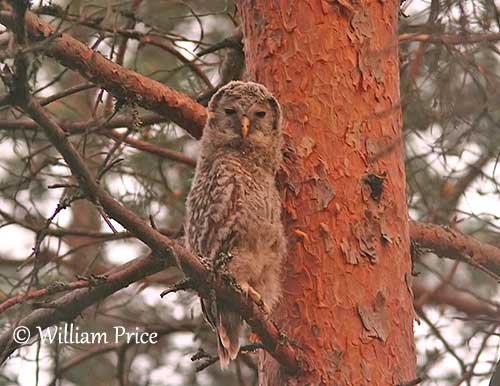
SUBSPECIES AND RANGE:
The Ural Owl has 8 to 15 subspecies according to the authors.
S.u. liturata ranges from N Europe (Fennoscandia) and NW Russia, S to N Poland, Belarus and middle of R Volga. It is darker than nominate.
S.u. uralensis is found from E European Russia E to Okhotsk Sea coast.
S.u. macroura occurs in C and SE Europe, from Carpathians Mts, S to Bulgaria and W Balkans. This race is darker and larger.
S.u. yenisseensis is found in C Siberian plateau (to N Mongolia).
S.u. nikolskii occurs in L Baikal region and Transbaikalia E to Sakhalin, S to NE China and Korea. This one is tinged brownish.
S.u. japonica occurs in N Japan (Hokkaido). This race is very pale.
S.u. hondoensis is found in C Japan.
S.u. fuscescens occurs in S Japan. This one is rufous-brown and much smaller.
S.u. davidi is found in C China and is named Sichuan Owl. This race is darker, with darker markings usually well-defined.
The race “davidi” is sometimes considered a full species.
HABITAT:
The Ural Owl frequents deciduous or mixed forest and woodland with clearings. In the N of the range, it favours open coniferous or mixed forest for breeding, with tall trees and clearings, mixed with alder and birch. In the S of the range, it occurs mainly in mountain beech forest.
It hunts over the adjacent clearings, farmlands and meadows, and is often close to habitations. In winter, it can be seen in parks and around fringes of settlements.
CALLS AND SONGS: SOUNDS BY XENO-CANTO
The Ural Owl male’s advertising song is a deep, far-carrying hooting “WHOOhoo…… whoohoo oWHOOhoo” with a pause of 3-4 seconds after the first double note. This phrase is repeated several times at short intervals. It also utters a rising and falling “hoohoohoohoohoohoo”. The female gives fairly similar song, a hoarser version of these calls.
The alarm call is a barking “waff” or “waff-aff” usually given in aggression. The contact call is a harsh “kuwett”.
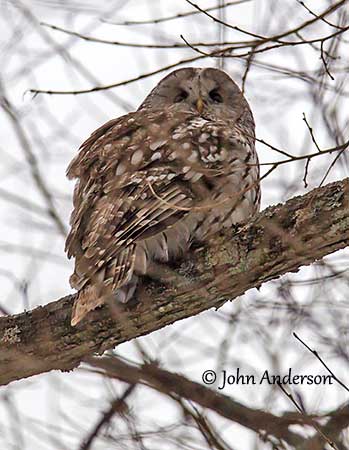
BEHAVIOUR IN THE WILD:
The Ural Owl feeds on mammals including voles, shrews, mice and rats. But larger prey such as young hare is also part of the diet. It also catches birds, from finches to pigeons, and even Black Grouses. Amphibians, lizards and insects are consumed too, and sometimes carrion.
The Ural Owl usually hunts at night and from perches, sometimes by flying low over the ground while searching for prey. It detects them by sound, even rodents hidden under 20-30 centimetres of snow. During the breeding season, it stores food at or near the nest.
The Ural Owl is monogamous with usually long-term pair bonds, often for life. In order to renew the pair bond, the male usually starts singing a month before the nesting period. It sings from several different perches and both mates can be heard duetting during the courtship. Displays involve courtship feeding, with male giving a prey to the female while she produces begging calls. The male performs wing and body movements while presenting the food to its mate. This display is followed by copulation. Flight displays are also reported in several species of genus Strix.
They are cavity-nesters, but they often use nest boxes. They are aggressive at nest-site and defend the large territory.
The Ural Owls are resident and even sedentary within their territories. They usually remain near their nest-sites. However, in severe weather conditions, the females may move 100-150 kilometres away, involving sometimes the change of breeding area if they can survive. They wander usually in W and C Siberia in autumn and winter. Young dispersal occurs between September and November.
The Ural Owl has powerful, direct flight. The wingbeats are rather slow and interspersed with glides as it flies away through the trees.
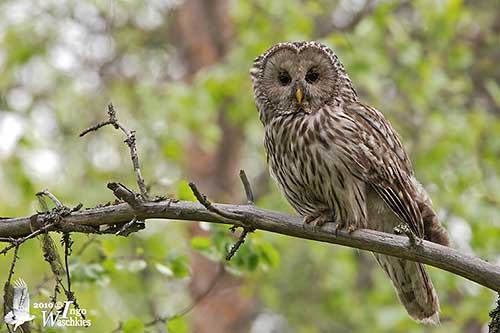
REPRODUCTION OF THIS SPECIES:
The breeding season takes place between February and July, with the laying from late March to mid-April.
The Ural Owl is a cavity-nester. It uses large natural holes in trees and cavities created by broken-off branches, also crevices and holes in cliffs, rocks or buildings. It may sometimes use a stick nest abandoned by larger bird. Nest boxes are often used in Finland and nearby countries.
The female lays 3-4 (occasionally 1-6) white eggs directly on the bottom of the nest without lining. The eggs are laid at intervals of two days. The incubation lasts 28-35 days by female alone, but she is regularly fed by her mate. At hatching, the chicks have white down and are brooded during two weeks by the female. Both parents feed them during about two months after fledging that usually occurs 35-40 days after hatching. They are able to fly some days later.
PROTECTION / THREATS / STATUS:
The Ural Owl is threatened in Fennoscandia by forestry management that involves removing of old trees and stumps very suitable for nesting. However, the provision of artificial nest boxes has led to good recovery.
The population depends mainly on food resources (small mammals). The Sichuan Owl (race davidi) is threatened by extensive deforestation in some parts of the range.
The global population is estimated to number 396,000/1,140,000 mature individuals, but this is a very preliminary estimate that needs further validation. This population appears currently stable and even increasing in Europe (BirdLife International 2015).
The Ural Owl is currently evaluated as Least Concern.
